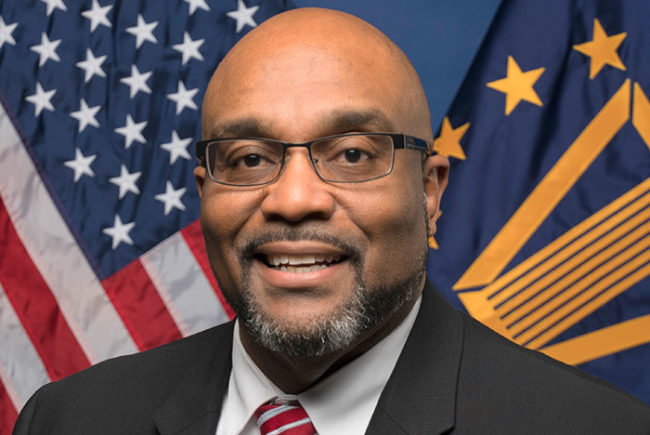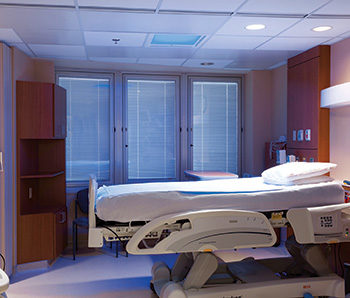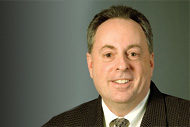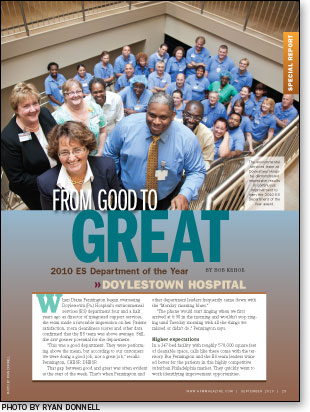 When Diane Pennington began overseeing Doylestown (Pa.) Hospital's environmental services (ES) department four and a half years ago as director of integrated support services, the team made a favorable impression on her. Patient satisfaction, room cleanliness scores and other data confirmed that the ES team was above average. Still, she saw greater potential for the department.
When Diane Pennington began overseeing Doylestown (Pa.) Hospital's environmental services (ES) department four and a half years ago as director of integrated support services, the team made a favorable impression on her. Patient satisfaction, room cleanliness scores and other data confirmed that the ES team was above average. Still, she saw greater potential for the department.
"This was a good department. They were performing above the mean, but according to our customers we were doing a good job, not a great job," recalls Pennington, CHESP, DHESP.
That gap between good and great was often evident at the start of the week. That's when Pennington and other department leaders frequently came down with the "Monday morning blues."
"The phone would start ringing when we first arrived at 6:30 in the morning and wouldn't stop ringing until Tuesday morning with all the things we missed or didn't do," Pennington says.
Higher expectations
In a 247-bed facility with roughly 578,000 square feet of cleanable space, calls like these come with the territory. But Pennington and the ES team leaders wanted better for the patients in this highly competitive suburban Philadelphia market. They quickly went to work identifying improvement opportunities.
As with most successful quality and process improvement efforts, there were no quick fixes. It took more than two years to complete the process that would bring the team to where it is now.
Today, the Doylestown Hospital's Sodexo-managed ES team is routinely at the top of its game. Its Press Ganey Associates Inc. patient satisfaction scores, which are available to the team online with real-time data, have soared from the 50th and 60th percentile for room cleanliness and courtesy in 2008 to the 90th and 95th percentiles in 2010, respectively. Room turnover times that once hovered around 90 minutes have been slashed to 53 minutes and have been sustained for nine months.
Refined hiring practices and behaviors-based training have produced a more engaged workforce, leading to reduced staff turnover and more satisfied patients. The tight-knit relation between the ES and infection prevention teams has helped to dramatically boost the already impressive efforts to eliminate hospital-acquired methicillin-resistant Staphylococcus aureus (MRSA) and Clostridium difficile (C. diff). Overall, the facility saw its hospital-acquired MRSA rate per 1,000 patient days drop to 0.09 percent in 2009 — a 76 percent reduction from 2008. The hospital's C. diff rate fell 27 percent to 0.62 percent during the same period.
 These and other accomplishments have earned Doylestown Hospital the 2010 ES Department of the Year award. Created four years ago by Health Facilities Management and the American Society for Healthcare Environmental Services, the award is sponsored by Cintas Corp.
These and other accomplishments have earned Doylestown Hospital the 2010 ES Department of the Year award. Created four years ago by Health Facilities Management and the American Society for Healthcare Environmental Services, the award is sponsored by Cintas Corp.
"The Doylestown Hospital ES team's achievements demonstrate their commitment to continuous improvement in areas ranging from patient satisfaction to infection prevention to deploying technology for greater efficiency to recycling," says Patti Costello, ASHES' executive director. "The submission was a well-rounded demonstration of improvement and staff engagement."
A clean slate
The facility's impressive transformation began about 30 months ago after two operations department manager positions turned over.
"We started from scratch," Pennington explains. "We wiped the slate clean with attendance and a lot of other things. We said, 'We're starting today and we're moving forward. As of today, here are the expectations.'"
This wasn't so much laying down the law as it was an attempt to get ES associates to better connect with patients. As Pennington puts it, "We wanted to make this about seeing the patient in the bed as your grandmother rather than as just another face."
Unlike some other areas of the department's improvement efforts, boosting patient satisfaction scores didn't produce immediate results.
"We had a pretty high turnover rate among our associates, so we started to look at the people we were interviewing and started hiring certain types of personalities that we felt would connect with our patients," says Rita Walker-Lewis, operations manager.
Associates were put through a two-week customer service boot camp. The customer service training provided role-playing opportunities, covering how to develop better rapport with patients.
"We set boundaries for the behaviors that we expected when you walked into the room. Knock on the door, introduce yourself, ask if it's a good time for cleaning to be done. Once we got that rolling, our associates became much more comfortable dealing with patients when they entered the room," Walker-Lewis says.
The implementation of a daily turndown service also won patients over, says William Dix, operations manager. As housekeepers went into patient rooms to check the trash and make sure the bathroom was clean during evening hours, they took two to three minutes to talk with the patients.
"We got a large response from that because usually someone would come in during the morning and that was it," Dix says. The improved patient satisfaction was reflected in Doylestown Hospital's Hospital Consumer Assessment of Healthcare Providers and Systems (HCAHPS) scores on the question covering whether the bathroom is always clean, rising 13 percentage points to 79.1 percent since the turndown service was introduced in April 2009.
Clifton Phillips, group leader, says the Sodexo managers' efforts to change the customer service culture steadily won over Doylestown Hospital's ES employees.
"We bought into this concept that they were selling and … the gap between the Sodexo employees and the Doylestown Hospital employees was bridged."
Preventing infections
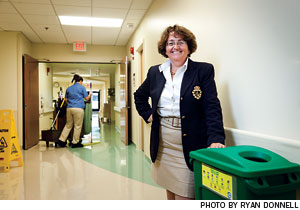 |
| Diane Pennington, director of integrated support services at Doylestown Hospital, helped spearhead waste reduction and recycling efforts. |
The ES team reinforced its strong partnership with the infection prevention team by focusing on better ways to reduce hospital-acquired infections. Together, they developed new tools and protocols for cleaning and disinfecting isolation rooms. They developed bilingual signs for each isolation type with visual cues that would be easily recognized by associates.
They also redefined procedures for enhanced precautions isolation. A system was developed to identify these rooms through bed tracking, which minimized errors in room cleaning where signage had been removed. Turn times are now tracked to validate that associates take the added time needed to clean these rooms.
In addition, operations managers routinely make rounds with the infection prevention managers, says Walker-Lewis, looking for opportunities for improvement throughout the facility.
"C. diff has been a major focus for us and the [infection prevention team] has done surveillance on hand washing. We've looked at it from the standpoint of getting the employees to clean better," Walker-Lewis says.
Operations managers reinforce the commitment to proper cleaning techniques by using black lights during room checks to help point out areas that were missed, emphasizing opportunities for improvement. Associates have embraced this verification process, she says, and now often ask to go through the room with a manager and the black light.
Doylestown Hospital has invested in many other technologies to help the ES team optimize infection prevention efforts as well as an integrated bed tracking system that has significantly improved patient throughput.
Sodexo's TRAKKAR management platform uses computer technology and handheld pocket PCs to engage staff members in driving quality enhancements for every area of the facility, notes Beth Palmer, supervisor. The system provides labor optimization and tracks employees, their responsibilities and outcomes. It also provides automated access to full training and competency records for each staff member. Meanwhile, bed-tracking software helps expedite patient admissions, boosts employee productivity and reduces the length of time dirty beds sit idle.
"Our bed-tracking system can do almost anything but put the patient in the bed physically," Palmer says.
Pennington notes that roughly 150 people, including many volunteers in patient transport, unit clerks, ES staff and others, have been trained to enter information into the bed-tracking system to help expedite patient flow. A supervisor is notified every 15 minutes if an associate has not responded to a bed that is vacated. These efforts, which relieved much of the burden in this area from nurses, contributed to the better than 41 percent decrease in bed turnaround times.
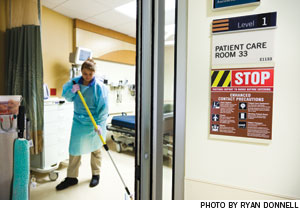 |
| Doylestown Hospital's ES and infection prevention teams developed effective new tools and improved protocols for cleaning isolation rooms. |
Looking to expand its use of technology to improve performance in other areas, Pennington's team has been evaluating an ultraviolet (UV) light germicidal disinfection system. Although the system would add about 10 minutes to the cleaning time of most patient rooms, it has the potential to cut the cleaning time on isolation rooms. Phillips says the UV germicidal light can also be used for disinfecting stretchers, IV poles and other difficult-to-clean equipment.
Green and clean
Elsewhere, the hospital's ES team has helped spearhead waste reduction and recycling initiatives at the facility. They participate in the Green Hospitals pilot program, a two-year program sponsored by the Healthcare Improvement Foundation, the Pennsylvania Department of Environmental Protection and the U.S. Environmental Protection Agency. The program is intended to develop baseline data and identify best practices in areas such as green buildings, red bag waste reduction/recycling and toxic waste reduction.
As part of this effort, the ES team has taken stewardship of a volunteer group responsible for "the greening of Doylestown Hospital." The Green Team, which formed in June of 2008, made an immediate impact on recycling efforts, boosting total recycling from 8 percent of total waste generated by the facility to 25 percent within a six-week period.
ES Department of the Year 2010: Runner-up
Successful by any measure
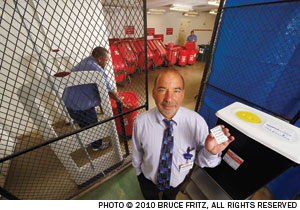 Tom Peck doesn't set modest goals. His annual objective for the environmental services (ES) team at the University of Wisconsin Hospital and Clinics (UWHC) in Madison is to be number one in the country in customer service. Over the past four years, the UWHC ES team has never been far from meeting that objective.
Tom Peck doesn't set modest goals. His annual objective for the environmental services (ES) team at the University of Wisconsin Hospital and Clinics (UWHC) in Madison is to be number one in the country in customer service. Over the past four years, the UWHC ES team has never been far from meeting that objective.
For the quarter ending Jan. 31, 2010, the UWHC ES team's Press Ganey Associates Inc. scores for room cleanliness ranked in the 96th percentile for academic medical centers and staff courtesy scores were in the 93rd percentile. At the end of 2008, UWHC scored in the 99th percentile in both areas.
Peck's team has a similarly stellar track record in utilizing technology to improve cleaning and bed turnover efficiency. UWHC has implemented innovative and highly effective systems to reduce infectious and pharmaceutical waste generation while steadily boosting recycling tonnage. The UWHC ES team, which finished as the runner-up in this year's ES Department of the Year competition, drew one of the highest scores since the award was created five years ago.
A highly data-driven ES director, Peck uses statistics to measure, educate and motivate his team of nearly 300 full-time equivalent employees. His color-coded performance dashboard, posted for all to see above the department's main office, serves as a daily reminder for each unit on the team of how they're faring in cleaning UWHC's more than 2.2 million square feet of space. The three-page table includes a litany of data on all phases of supervisor and associate performance, including average time for STAT bed and operating room turnover, patient satisfaction scores on room cleanliness and staff courtesy, spending on cleaning supplies and more.
"I'm very data-oriented. In fact, when the hospital hires new employees for the department, that's one of the things that's brought up," Peck laughs. "I try to make all of my decisions based on hard information. I also find it comes in very handy at budget time in justifying current and new positions."
Peck's devotion to measuring and monitoring data from waste reduction and recycling initiatives has produced a raft of achievements. For instance, during 2009 UWHC recycled more than 513 tons of materials. Recycling of confidential materials alone saved more than 537 cubic yards of landfill space. The residual benefits of these efforts resulted in more than $9,000 in annual savings on plastic bags and paper towels.
A relatively simple but highly effective program Peck and his team instituted brought roughly a 50 percent reduction in the amount of infectious waste generated by UWHC. The results came about from a combination of random surveys of infectious waste containers, staff education and working with department managers on reducing the number of unused infectious waste containers.
Peck says the random surveys routinely showed that much of what was discarded in these containers was not infectious waste. Surveys of OR containers, for example, turned up glove boxes, plastic wrap and other noninfectious waste.
An interdepartmental project aimed at creating a separate stream for pharmaceutical waste and to ensure it wasn't commingled with other UWHC waste also has produced positive results. Peck says the group effort among the ES, nursing and pharmacy departments resulted in using black bins with radio frequency identification (RFID) tags attached by the ES staff for all pharmaceutical waste. The tags trigger an alarm if the black bins are inadvertently brought into one of the separate rooms that are designated for nonregulated and infectious waste.
"By doing this, we've eliminated any black box waste from entering the regular waste stream. This was also quite inexpensive. It costs us about $100 a year for RFID tags and the system installation was about $2,500," Peck says.
Looking forward, Peck knows just what it will take to lead his team to reaching their goal of being the best in the nation.
"We have learned what our patients expect and it is actually quite simple: a clean, safe and pleasing healing environment with a pleasant and patient-oriented staff," Peck says.
Bob Kehoe is executive editor and associate publisher of Health Facilities Management magazine.



